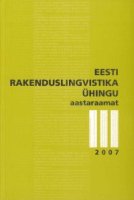Ladina keelest pärit terminite polüseemia ja sünonüümia eesti õiguskeeles
Polysemy and synonymy of Latin terms in Estonian legal language
Author(s): Merike RistikiviSubject(s): Language and Literature Studies
Published by: Eesti Rakenduslingvistika Ühing (ERÜ)
Keywords: legal language; terminology; terminological dictionaries; lexical semantics; language contact; polysemy of terms; synonymy of terms; Latin; Estonian
Summary/Abstract: The article discusses some problems of polysemy and synonymy occurring in Latin legal language. The material analysed comprises the terms collected for the compilation of theLatin-Estonian Juridical Dictionary (2005). Polysemy is generally avoided in terminology. However, absolute monosemy is not in accordance with the principles of language functioning . The meaning of the term reflects the local conditions and time in which it is used, and its usage may become more specific or more general, or the term may even come to denote a totally different idea. In the case of polysemy the meanings of the terms become distinct first in the common language and legal language. Polysemy also occurs in the legal language across the various areas of law. Different meanings for the same terms have developed in penal power and civil law, for example. The meaning of legal terms also varies in the usage characteristic of different legal systems. Legal language differs from language for other specific purposes in one significant aspect: it is culturally determined, associated with an individual society and its legal system. Even though European legal thinking is generallybased on the common heritage of Roman Law and the terms originating from it have become rooted in modern legal systems, the meanings of Latin legal phrases oftendiverge depending on whether they are used in the Anglo-American legal system or in continental Europe. Smaller differences between the meanings of identical terms can also be found in the use of legal language of Romance and Germanic legal families. The synonymous variants of Latin legal terms do not vary on the level of legal systems and linguistic boundaries. Synonymy occurs mainly between two single words, but it can also appear between a single word and a phrase, with the latter being more specific. Also, synonymy can be observed between phrases or expressions themselves. Often grammatical and orthographic variants appear, and a term and its abbreviated form may exist in parallel. The most common type of lexical variants is the parallel existence of a foreign term and a native term. The trend is towards using foreign words more readily in professional writings, particularly on the level of international communication and information exchange, whereas native phrases are preferred in more general writings and writings in the native language.
Journal: Eesti Rakenduslingvistika Ühingu aastaraamat
- Issue Year: 2007
- Issue No: 3
- Page Range: 253-267
- Page Count: 15
- Language: Estonian

